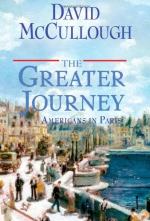
|
| Name: _________________________ | Period: ___________________ |
This test consists of 15 multiple choice questions and 5 short answer questions.
Multiple Choice Questions
1. What was considered the grandest and most exuberant expression of the Second Empire opulence?
(a) The Louvre.
(b) Theatre de l'Opera.
(c) Les Halles.
(d) Place du Pantheon.
2. What did Louis Napoleon Bonaparte say was his power?
(a) His family history.
(b) His looks.
(c) His charm.
(d) His name.
3. At what university did Samuel Morse teach art after leaving Paris?
(a) Columbia.
(b) New York University.
(c) Harvard.
(d) Yale.
4. What did Americans find unusual about the length of a day in Paris?
(a) The days were much shorter in the summer.
(b) The days were much longer in the winter.
(c) The sun shone later in the day during the summer.
(d) The sun shone earlier in the day during summer.
5. With whom did James Fenimore Cooper walk the entire circumference of the city on foot?
(a) Samuel Morse.
(b) John Sanderson.
(c) Melancthon T. Woolsey.
(d) David Farragut.
6. Why did Victor Hugo move to Belgium in 1851?
(a) To aid his health.
(b) To have the freedom to speak his mind about the new French government.
(c) To escape prosecution.
(d) To join his family.
7. Who was the first American to be admitted to the Ecole des Beaux-Arts?
(a) William Morris Hunt.
(b) Richard Morris Hunt.
(c) George Healy.
(d) Charles Sumner.
8. What fashion among male Parisians did John Sanderson criticize during his time in Paris?
(a) Blousy slacks.
(b) Oversized shirts.
(c) High pompadour haircuts.
(d) Beards and mustaches.
9. What was James Fenimore Cooper's most well known novel prior to his travels to Paris?
(a) The Last of the Mohicans.
(b) The Deerslayer.
(c) The Ways of the Hour.
(d) Lives of Distinguished American Naval Officers.
10. Who is Natty Bumppo?
(a) A character in several James Fenimore Cooper's novels.
(b) Oliver Wendell Holmes' cousin.
(c) George Healy's uncle.
(d) Samuel Morse's daughter.
11. Why did Oliver Wendell Holmes choose to travel to Paris in the 1830s?
(a) To learn from Parisian artists.
(b) To vacation.
(c) To further his education.
(d) To join friends.
12. What is the Sorbonne?
(a) A highly respected Paris university.
(b) A church.
(c) An art museum.
(d) A Paris hospital.
13. Where did many Americans in the 1830s get their information on Paris and its culture?
(a) From the styles and art of Paris.
(b) From the newspapers and literature.
(c) From previous travels.
(d) From gossip.
14. Who was the Marquis de Lafayette?
(a) Leader of the French government.
(b) A French theater star.
(c) Cousin to the French king.
(d) A French aristocrat and American Revolutionary hero.
15. What profession did Ralph Waldo Emerson leave prior to going to Paris in 1833?
(a) Artist.
(b) Preacher.
(c) Lawyer.
(d) Teacher.
Short Answer Questions
1. What did Ralph Waldo Emerson say was one of the chief draws of Paris to young men?
2. How did theater help Americans learn French?
3. What took place on September 2, 1851?
4. What was the first news article to appear about the daguerreotype in the United States?
5. What were the June Days of 1848?
|
This section contains 576 words (approx. 2 pages at 300 words per page) |

|




